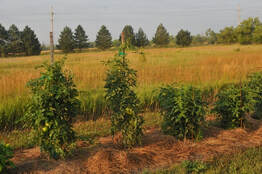 Tomatoes are often classified as determinate, semi-determinate or indeterminate. Determinate plants produce one large crop and then virtually nothing thereafter. They are favored by commercial growers that want to harvest most of the fruit from one picking. They then use succession plantings where a new crop is planted on a set schedule to have fruit production throughout the season. Mature plants are smaller than other types and can be planted closer together to get the most tomatoes from a set space. Primo Red is a variety that is strongly determinate. Indeterminate plants are the traditional tomatoes that never stop growing. They are capable of producing fruit throughout the season unless disease stops production or until frost kills the plant. They do best with support as they can reach six feet tall when staked or caged. Semi-determinate plants are more compact than indeterminate types but are also capable of producing fruit throughout the season. Most of the varieties available to home gardeners are either indeterminate or semi-determinate. Though both are capable of producing fruit throughout the season, our hot Kansas summers often cause a dry spell in production of both types. Tomatoes are less likely to set fruit when night temperatures remain above 75 degrees and day temperatures are above 95. Hot, dry winds make the situation worse. Gardeners with limited space will likely prefer indeterminate or semi-determinate types to stretch out the harvest season. If there is space, you may want to grow a combination of all three with the determinates used to produce a large harvest for canning or tomato juice and the remainder for fresh eating. (Ward Upham) 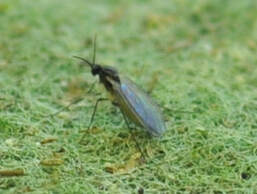 Fungus gnats are small insects (1/8 to 1/10 inch long) that are common in high-organic-matter houseplant soils that are kept moist. Though adults are mosquito-like in appearance, they do not bother humans or pets. It is actually the larvae or maggots that can injure plants by feeding on the roots. Symptoms include sudden wilting, loss of vigor, poor growth and yellowing leaves. Use of sterile media and avoiding overwatering your houseplants can help prevent infestations. Existing infestations can be controlled Bacillus thuringiensis v. israelensis which is sold under the names of Gnatrol and Knock-Out Gnats. (Ward Upham) 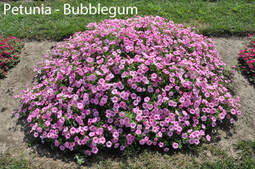 If you have had trouble finding a listing of plants recommended for Kansas, visit our web page devoted to this topic. We have links to a wide variety of plants including iris, daylilies), fruit, vegetables, turfgrass, low-maintenance roses and tree recommendations. The tree recommendations are broken out by areas of the state. We also list recommended low water use plants. You can find this page at http://hnr.k-state.edu/extension/info-center/recommended-plants/ We also have images of hundreds of the following: - Varieties of iris, daylilies, roses and peonies found in the University Gardens Collection Gardens at http://www.k-state.edu/gardens/gardens/collections/ (Ward Upham) 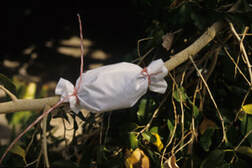 We sometimes receive calls from gardeners who wish to donate houseplants that have outgrown their location. In most cases, we don’t have room to accept plants and suggest that people bring them down to size by air-layering. Air-layering is a process where a branch or the main stem is encouraged to form roots while still attached to the parent plant. After rooting, the original plant is discarded and the newly rooted one is potted as a replacement. Though this propagation technique cannot be used on all houseplants, it does work well on many that tend to outgrow their boundaries including croton, dracaena, dieffenbachia, Norfolk Island pine, rubber plant and schefflera. It is best to choose wood that is about 1 year old. Older or more immature wood often roots poorly, if at all. Any place on the stem that is of the proper maturity can be used, but a convenient location is often about 12 inches from the tip. Following are the steps required for air-layering: * Leaves should be removed around the area to be air-layered. * Wound the stem. This can be done by making a slanting cut upward, an inch or more in length and halfway through the stem. Place a portion of a toothpick in the cut so it cannot close and heal. If the stem is seriously weakened, use a stick or dowel “splint” to prevent breakage. Another method that works well is to strip the bark completely around the stem in a band one-half to one inch wide. * Apply rooting hormone to the wounded surface of the cut or the stripped portion of the branch. * Pack a baseball-sized wad of moist, unmilled sphagnum peat moss around the wounded area so it forms a ball. This is where new roots will form. It is important to use the long, stringy unmilled peat moss rather than the more common milled material so peat moss does not fall away from the stem when released. Even unmilled peat moss may need to be secured with string to keep it in place. * Wrap the ball of sphagnum peat moss with clear plastic wrap. Be sure to use enough wrap so that the plastic overlaps and prevents the ball from drying out. Secure the top and bottom edges of the wrap closed with electrical tape, string or other convenient fastener. Roots may appear in as little as a month though it may take much longer for the plant to be ready for transplanting. Check periodically to be sure peat moss remains moist. Water if needed. When roots have filled the peat moss, the plant is ready to be severed from the parent and transplanted. (Ward Upham) 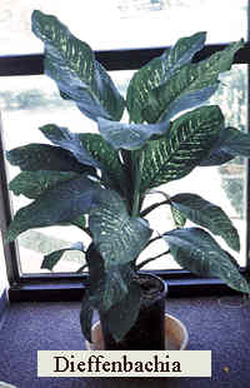 Some of the plants we commonly use in our homes, gardens and landscapes are poisonous. We often have requests from parents who want to make sure their plants are safe for young children. The following poisonous plant list came from various University websites. Flowers caladium (all parts) cardinal flower (all parts) castor bean (seeds and leaves) daffodil (all parts) flowering tobacco {Nicotiana} (leaves and flowers) four-o-clock (roots and seeds) foxglove (all parts) hellebore (all parts) iris (all parts) lantana (unripe fruits and leaves) larkspur {Delpinium} (all parts) lily of the valley (all parts) lupine (all parts) monkshood(all parts) poppy (all parts except ripe seeds) snowdrop (bulb) spurge (milky sap) star-of-Bethlehem (all parts) sweet pea (seeds, seedlings, and pods) tulip (bulbs) Houseplants Chinese Evergreen anthurium (all parts) aloe (sap if ingested) calla lily (all parts) croton (seeds, leaves, and stems) crown-of-thorns (milky sap) dieffenbachia (all parts) elephant ear (all fig (leaves, fruits, and sap) Jerusalem Cherry (all parts) mistletoe (all parts) Philodendron (all parts) Fruits apple (bark, leaves, seeds) pear (bark, leaves, seeds) apricot (bark, leaves, seeds, pits) peach (bark, leaves, seeds, pits) nectarine (bark, leaves, seeds, pits) plum (bark, leaves, seeds, pits) cherry (bark, leaves, seeds, pits) avocado (leaves, unripe fruit, bark, and seeds) Landscape plants azalea (leaves and flowers) black locust (all parts) Boston ivy (berries) boxwood (leaves and twigs) buckeye (leaves, shoots, bark, flowers, and seeds) burning bush (all parts) cherry (leaves, twigs, bark, and seeds) clematis (leaves) elderberry (roots, stems, bark, leaves, and unripe fruits) English ivy (all parts) golden chaintree {Laburnum} (all parts) holly (berries and leaves) horsechestnut (all parts) hydrangea (leaves and buds of some species) Kentucky coffee tree (seeds, fruit pulp, leaves, twigs) oak (acorns, leaves, and young shoots of some species) poison sumac (all parts) privet (all parts) rhododendron (leaves and flowers) Virginia creeper or woodbine (berries) yew {Taxus} (all parts except the fleshy red cover on the seed) wisteria (all parts) Vegetables potato (green skin, buds, and sprouts on tubers, also fruits and foliage) rhubarb (leafy blade, not the leaf stalk) For more information, consult the following references. Common Poisonous Plants and Mushrooms of North America, Turner and Szcawinski, Timber Press, Inc. ISBN 0-88192-179-3 Potentially Poisonous Plants in the House and Garden, http://www.northcarolinahealth.com/poisonous-house-plants-and-vegetables.php (Ward Upham) 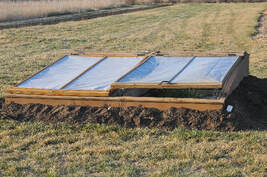 Uses of Coldframes Hotbeds These mini-greenhouses can be useful for serious gardeners. Though often used for hardening off seedlings, they can also be helpful in extending the growing season in the fall for cool-season vegetables such as lettuce, kale, green onions, and radishes. You may also want to start pansies in the fall, overwinter them in the cold frame, and set out large plants that give immediate color in the spring. Cold frames also can be used to overwinter nursery plants or give the cold treatment needed to force bulbs. In these last two cases, the cold frame is covered with a tarp or something similar late in the fall just before the ground freezes so that the temperature hovers just above freezing. During the summer, you can remove the top and use the structure as a nursery. A hotbed can function like a coldframe if not heated. Adding heat allows plants to be started earlier. Cold frames and hotbeds used to require almost constant attention during the day due to venting requirements. Venting is absolutely necessary on bright, sunshiny days, even if the outside temperature is relatively cool. If the frames are not vented in a timely manner, the plants can easily overheat. Venting in normally done by having the sash hinged to the main structure. This sash is propped open to let excess heat escape whenever temperatures demand. Though sashes can be propped open by hand, today we have automatic ventilators that use a temperature-sensitive compressed gas to automatically open sashes. These are often called solar vents as they rely on the sun to heat up the interior of the coldframe or hotbed to activate the vent. Solar vents do not require an external power source and can be set to open at different temperatures. An important feature that many solar vents do not have is the ability to release quickly so the lid on the coldframe or hotbed can be opened completely. This makes watering much easier. As mentioned, many solar vents do not have the quick release feature. Two that do are the Univent Standard and Agetc Automatic Vent Opener. If you know of any others, let me know and we can list them in a later newsletter. Basic Design of Cold frames and Hotbeds The structure of both cold frames and hotbeds is the same. Basically it's a box covered with glass, plastic or clear fiberglass sash. The box size varies but is often 5 to 6 feet deep and 6 to 12 feet wide. Height also varies but is often about 18 inches in the back and 12 inches in the front. The slope should face south so that rays from the winter sun can be captured more easily. The only difference between a cold frame and a hotbed is that hotbeds contain a heat source. In the early part of last century, that heat source was often 12 to 24 inches of fresh, straw-laced horse manure placed in a pit under the structure. Today, electric heating cables are often used. Hotbeds are more versatile than cold frames and allow young, tender plants to be started earlier in the year. Cold frames and hotbeds can be purchased, or you may want to build your own. Plans for constructing either structure can be found at: https://extension.missouri.edu/media/wysiwyg/Extensiondata/Pub/pdf/agguides/hort/g06965.pdf (Ward Upham) 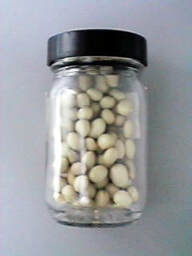 If you wish to save vegetable seeds from one year to another, there are certain things that must be kept in mind. Seed from hybrid varieties will not come back true. In other words, the plants grown from seed from a hybrid will grow but will be quite variable and will not be like the parent. For example, if you save seed from a hybrid tomato, you will still get a plant that produces tomatoes but yield will likely be much less and the fruit will lack many of the good characteristics of the parent. If you want a plant just like the parent, you must use seed from an open-pollinated variety rather than a hybrid. Heirloom plants are open-pollinated. Any plant listed as an “F1" is a hybrid. Not only must you use open-pollinated plants but you must prevent contamination from other plants of the same species. Note that contamination from other varieties has absolutely no effect on the current season’s fruit characteristics. It only affects the fruit grown from seed of those contaminated varieties. Preventing cross-contamination can be done via several methods. • Distance: make sure that your plants are far enough away from other varieties of the same species that the pollen from neighboring plants cannot reach yours. The distance varies considerably depending on species and whether the plant is wind or bee pollinated. • Mechanical: This can be as simple as covering the unopened female flower of a bee pollinated plant with a bag and then hand pollinating with the male flower of the same variety. The bag is then placed back over the flower until the fruit starts to form. This is commonly used for the vine crops such as squash, muskmelon and watermelons as these produce separate male and female flowers and are bee pollinated. Another mechanical method is to place a screened-in cover over plants that are bee pollinated. This would work well for peppers. • Time of Flowering: Commonly used for sweet corn. Many farmers will plant a small area of sweet corn in with their field corn even though sweet corn quality is much less if it crosses with field corn. The reason this can work is usually the sweet corn has finished pollination by the time the field corn tassels, thereby preventing contamination. This seems way too complicated. Is there an easy way to start? Yes there is! Start with tomatoes. They will not cross-pollinate unless you grow a potato-leaved variety. Therefore, you can grow several different open-pollinated varieties in the same garden without worrying about contamination. If you would like to save seed from other species, I would suggest you buy a good reference. The book I use is “Seed to Seed” by Suzanne Ashworth. (Ward Upham) 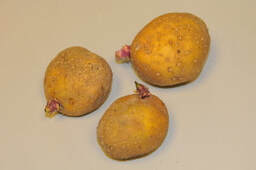 Home gardeners have had to rely on proper storage conditions (cool and moist) to prevent potatoes from sprouting. But sprouting will eventually occur even if the gardener does everything right. Research by Mary Jo Frazier, Nora Olsen and Gale Kleinkopf from the University of Idaho have found products that should help home gardeners. These researchers were looking for an organic method to control potato sprouts. They found essential oils from some herbs and spices to be effective sprout inhibitors. Specifically they found that spearmint oil, peppermint oil and clove oil suppressed sprouting by physically damaging rapidly dividing cells in the sprout. Each of these products is so safe that the FDA has approved them for addition to food. Several application methods were considered though most were only suitable for commercial storage facilities. The only practical method for homeowners was one the researchers labeled a “low-tech” wick method. This was accomplished by placing a small piece of blotter paper saturated with spearmint or peppermint oil in a box with the potatoes. This method was not recommended for the clove oil. Though it was found that peppermint and spearmint oils were equally effective in suppressing sprouts, the peppermint oil was less likely to affect flavor of the potatoes. Reapplication at two- to three-week intervals will be needed for continued sprout suppression. Little to no residue was found on the potatoes from these products due to their high volatility. The first application should be done before sprouting occurs. Blotting paper is much more difficult to find than it was in the past and so you may want to substitute blank newsprint. However, if blotting paper is desired, try herbarium supply houses. Blotting paper is used to press plant specimens. (Ward Upham) |
AuthorsCynthia Domenghini runs the Horticulture Response Center in the Department of Horticulture and Natural Resources at Kansas State University. Other contributors include K-State Extension Specialists. Archives
March 2024
Categories
All
|
| K-State Research and Extension Horticulture Newsletter |
|
 RSS Feed
RSS Feed
